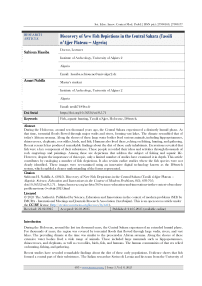Discovery of New Fish Depictions in the Central Sahara (Tassili n'Ajjer Plateau – Algeria)
Автор: Safrioun H., Nabilla A.
Журнал: Science, Education and Innovations in the Context of Modern Problems @imcra
Статья в выпуске: 5 vol.8, 2025 года.
Бесплатный доступ
During the Holocene, around ten thousand years ago, the Central Sahara experienced a distinctly humid phase. At that time, torrential floods flowed through major wadis and rivers, forming vast lakes. The climate resembled that of today's African savanna. Along the shores of these large water bodies lived various animals, including hippopotamuses, rhinoceroses, elephants, crocodiles, birds, and fish. Humans also lived there, relying on fishing, hunting, and gathering. Recent research has produced remarkable findings about the diet of those early inhabitants. Excavations revealed that fish were a key component of their subsistence. These people recorded their ideas and activities through thousands of rock engravings and paintings. Among these are depictions that address the subject of fishing and aquatic life. However, despite the importance of this topic, only a limited number of studies have examined it in depth. This article contributes by cataloging a number of fish depictions. It also revisits earlier studies where the fish species were not clearly identified. These images were re-examined using an innovative digital technology known as the DStretch system, which enabled a clearer understanding of the forms represented.
Fish, aquatic hunting, Tassili n'Ajjer, Holocene, DStretch
Короткий адрес: https://sciup.org/16010718
IDR: 16010718 | DOI: 10.56334/sei/8.5.71
Текст научной статьи Discovery of New Fish Depictions in the Central Sahara (Tassili n'Ajjer Plateau – Algeria)
RESEARCH ARTICLE Discovery of New Fish Depictions in the Central Sahara (Tassili n'Ajjer Plateau – Algeria) Safrioun Hassiba Doctor, Lecturer Institute of Archeology, University of Algiers 2 Algeria Email: Amari Nabilla Master's student Institute of Archeology, University of Algiers 2 Algeria Email: Doi Serial Keywords Fish, aquatic hunting, Tassili n'Ajjer, Holocene, DStretch. Abstract During the Holocene, around ten thousand years ago, the Central Sahara experienced a distinctly humid phase. At that time, torrential floods flowed through major wadis and rivers, forming vast lakes. The climate resembled that of today's African savanna. Along the shores of these large water bodies lived various animals, including hippopotamuses, rhinoceroses, elephants, crocodiles, birds, and fish. Humans also lived there, relying on fishing, hunting, and gathering. Recent research has produced remarkable findings about the diet of those early inhabitants. Excavations revealed that fish were a key component of their subsistence. These people recorded their ideas and activities through thousands of rock engravings and paintings. Among these are depictions that address the subject of fishing and aquatic life. However, despite the importance of this topic, only a limited number of studies have examined it in depth. This article contributes by cataloging a number of fish depictions. It also revisits earlier studies where the fish species were not clearly identified. These images were re-examined using an innovative digital technology known as the DStretch system, which enabled a clearer understanding of the forms represented. Citation Safrioun H. Nabilla A. (2025). Discovery of New Fish Depictions in the Central Sahara (Tassili n'Ajjer Plateau – Algeria). Science, Education and Innovations in the Context ofModern Problems, 8(5), 693-705; doi:10.56352/sei/8.5.71. Licensed © 2025 The Author(s). Published by Science, Education and Innovations in the context of modern problems (SEI) by IMCRA - International Meetings and Journals Research Association (Azerbaijan). This is an open access article under the CC BY license . Received: 22.02.2025 Accepted: 26.03.2025 Published: 24.05.2025 (available online)
During the Holocene, around the last ten thousand years, the Central Sahara experienced an extended humid phase. For thousands of years, the region was covered by torrential floods that flowed through large wadis, rivers, and vast lakes. The prevailing climate at the time was similar to the present-day African savanna. Along the shores of these extensive water bodies lived a wide range of animals. These included large mammals such as hippopotamuses, rhinoceroses, and elephants, as well as crocodiles, birds, fish, and humans. The human communities of that era relied on hunting, fishing, and gathering.
Recent studies have revealed remarkable findings about the diet of these early populations. Evidence shows that fish formed a central part of their subsistence. The Italian researcher Savino di Lernia and his team from the University of
Figure 1- Material Evidence from the Gobero Site: Long Spears and Fishing Hooks (Serrino, BC et al., 2008, Fig. 7:14)
The ancient Saharan human left behind visual records of daily life and thought. These appear in thousands of painted and engraved scenes on the surfaces of rock shelters near which they lived. Because many of these images depict aspects of daily life and various activities, it has been possible to document fishing practices and their different uses.
Despite this, studies focusing on rock art representations of fish are few. Academic research in this area remains limited and still requires extensive work.In one such effort, researchers Claude and Yvette Gauthier published a study on fish forms from the “Round Head” period. That same year, the French researcher François Soleilhavoup published a paper aiming to document and inventory as many rock art depictions of fish and fishing in the Central Sahara as possible. However, despite the seriousness of his approach, many scenes were not identified, likely due to the limitations of the available research tools at that time, which did not allow for better results.(Gauthier, C. & Gauthier, Y., 2011; Soleilhavoup, F., 2011)
This paper aims to revisit a number of rock art scenes from the Tassili Plateau—many of which have been previously studied. However, through our new analysis, we document fish figures that were not previously identified. These discoveries were made using a digital imaging technique known as DStretch. This tool can digitally enhance faded rock art by isolating color channels, making previously invisible details more legible. This method has enabled the identification of multiple fish shapes within scenes already studied, and its application has yielded significant results.(Le Quellec, JL, 2013)
Reinterpreting Fish Scenes Using the DStretch System
-
1 . Tin Tazarift Site
Fish Figure No. 1
Before DStretchprocessing:
On the surface of a rock shelter, containing images painted in dark red pigment, we observe a scene featuring small humanoid figures described as “diablotins” (little demons), along with a depiction of a baboon. Above the baboon, we identified a sketch-like outline of what appears to be a fish. It was drawn with a somewhat thick or coarse line, using white pigment. The basic contours are marked: the head is shaped like a cone and separated from the body by a clear line. Two short lines appear below the body, and the tail fin is shown in a shape resembling a boat rudder (see Plate 1A).
After DStretchprocessing:
The coarse outline of the figure becomes clearer. The fish contours appear to be redrawn in parts, possibly to emphasize the dorsal fin. On the lower part of the body, two short lines are also visible, one of which appears to have been retraced. The head is again shown as a cone, separated by a defined line from the body. The tail fin retains the rudder shape, originating not from the extreme end but slightly inward from the edge. Several short, nearly parallel horizontal lines appear within the tail area, varying in thickness (see Plate 1B).
Fish Figure No. 2
Before DStretchprocessing:
On the same rock surface, above one of the small human figures—possibly shown dragging or pulling another figure, perhaps female—we noticed another faint outline. This corresponds to a simplified form, likely representing a fish, drawn in white pigment and dating to the Round Head period.
After DStretchprocessing:
The form clearly resembles a fish with a spindle-shaped body and coarse edges. The interior appears filled with white pigment. The tail fin is fan-shaped, from which several short, closely spaced lines extend. The head is distinctly separated from the body by a thick dividing line. This fish depiction aligns with a figure from the Round Head period. Only the head of the humanoid figure is visible, and it corresponds with another smaller, likely female figure, rendered in dark red pigment in the same panel (see Plate 1).
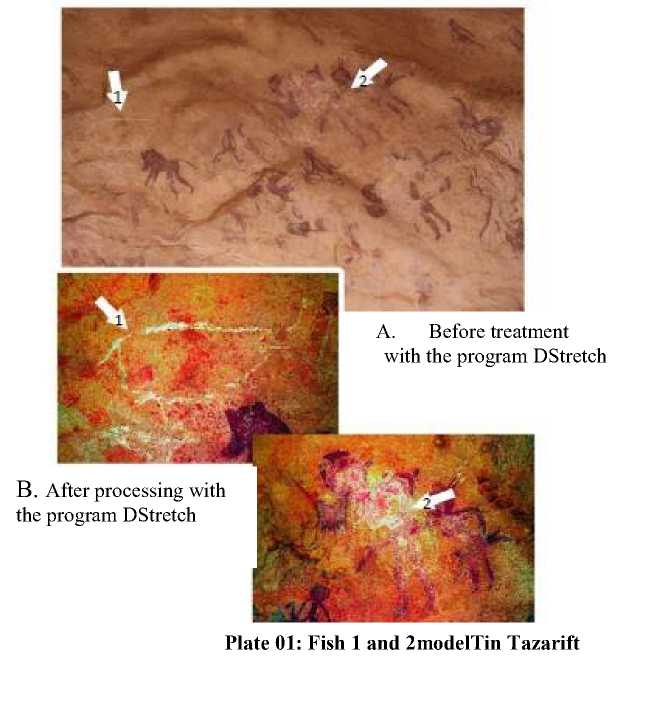
B. a fter processing with the program DStretch
Plate 01
A. Before treatment with the program DStretch
: Fish 1 and 2modelTin Tazarif t
Site 2: Tin Tazarift
Before DStretch Processing: On the surface of a large rock shelter, we observed four linear figures with defined edges drawn in dark red color. Inside each body, a flat white pigment was applied. These figures likely represent fish. They correspond to another figure drawn in the same dark red pigment and also filled with white. That figure seems to represent a mammal—possibly a bull—carrying a curved or hook-shaped object.
Several observations can be made about the four figures that likely represent fish:
From left to right, the first fish faces the opposite direction from the other three. Its tail appears to be connected to a long stick or a tool for resembling a gripping instrument.
All four figures display short, parallel lines on the upper part of the body. On the lower part, each shows four small projections—two at the front and two at the rear. The only exception is the fish figure on the far left of the panel, which shows only upper body lines.(Plate 2A)
After DStretch Processing: The short, parallel lines are more clearly visible. These lines extend from the head to what appears to be the tail fin, except in the figure on the leftmost side. The four small projections also become more distinct—two located at the front and two at the back. These features give the impression of motion, as if the fish are in a swimming position.
The last fish, on the far left of the panel, seems connected to the lower part of a large human figure. A long rod or object resembling a clamp appears to extend from this figure. One end of the object holds another, smaller human figure. Both human figures are positioned similarly to the four fish and appear as part of the same composition in the background.
The other end of the tool resembles a clamp or possibly a type of fishing implement.(Plate 2B)
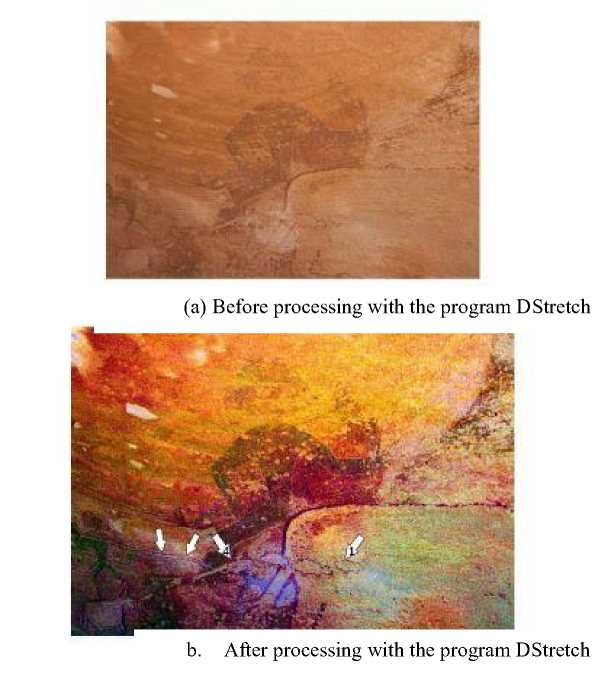
(a) Before processing with the program DStretch b. After processing with the program DStretch
Plate02: Fish 1 and Tin Tzarift Model 2
Plate 2 – Site: Tin Tazarift2 – Four Fish and a Rod-Shaped Object, Possibly a Clamp?
A question arises about the large rod-shaped object that resembles a clamp or a pincer. Could it be related to the figures that seem to represent fish? And if so, might this be a depiction of a fishing tool?
From a Bibliographic Perspective:
Site 1 – Tin Tafrest before DStretch Processing:
On the surface of a rock shelter, in poor preservation condition, beneath a scene showing two figures working with palm fronds and painted in dark red ochre, we observe a faint line drawing made in lighter red ochre. The form possibly represents a fish, suggested by the presence of short, parallel lines running along the upper edge, and by small protrusions appearing along the lower side of the figure. We also noted some clear shapes above and to the left of this figure. (Plate 3A)
After DStretch Processing:
The form of a large fish becomes clearer. On the upper part of the body, we can see short, somewhat parallel lines, likely representing the dorsal fin. These lines extend from the head to the rear of the body. At the back, the figure shows a form resembling a boat rudder, which likely represents the tail fin. On the lower side of the body, several small protrusions are visible. These may represent the pelvic fin.
The DStretch processing also revealed another fish figure below the first one. This second fish also appears large, with a distinct triangular tail fin visible on its right side. The other forms in the scene remain clear, likely due to the advanced deterioration of the rock shelter's surface.
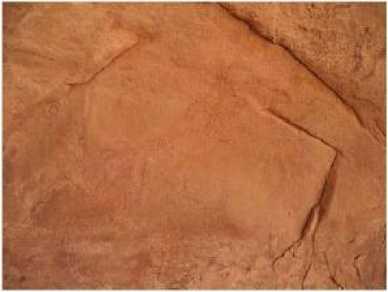
-
A. Before processing with the program Dustrich
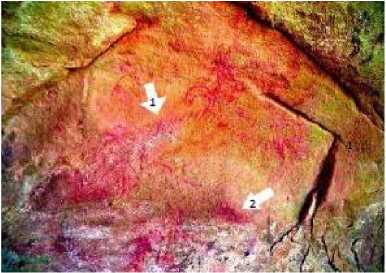
b. After processing with the program Dustrich
Plate 0 3- Tin Tafrist :Big Fish 1 and 2
Gauthier's Reference to the Fish Depiction
The researchers Gauthier refer to this fish as being of the same type that appears at another location in the Tin Tafrest site. It also features in the tracings made by researcher Sansoni in 1994 and in the photographs published by researcher Le Quellec. However, the degraded state of the drawings has made them difficult to interpret. (Gauthier, PC & Y., 2011; Fig. 122)
Site: Safar (Ouan Mellen)
Before DStretch Processing:
On the surface of a rock shelter wall, located a few meters from the main shelter of the “Great God of Safar,” we observed several line drawings. These were executed in red light and are in a poor state of preservation. The general shapes suggest possible fish representations.
After DStretch Processing:
The forms become somewhat clearer. The figure located at the top of the panel appears to be a large fish. It includes a representation of the mouth and a broad, slightly curved band at the end, likely symbolizing the tail fin. In the middle of the body, there are several other lines—mostly parallel—which may not be part of the original figure.
Below this shape and to its left, there are two other drawings made with double lines. They likely depict two small fish, one positioned above the other, with its head pointing upward or toward the upper fish. It has an almond-like shape ending in a small triangle at the rear. This triangular end, also drawn with double lines, probably represents the tail fin.
The second figure appears to be a somewhat large and flat fish. It has an almond-shaped body, with clear features such as a curved line separating the head from the body and a small open arc at the end, from which several fine, parallel lines extend. These likely represent the caudal fin.
To the left of these two similar fish figures, there are two elongated shapes (labeled 4 and 5). These likely represent the fourth fish. Several short, closely spaced lines appear along the top edge of this form. A band composed of two lines can also be seen at each end of this fourth fish figure.
As for the fifth fish shape, it appears as an elongated figure, with clear markings along both the upper and lower edges.
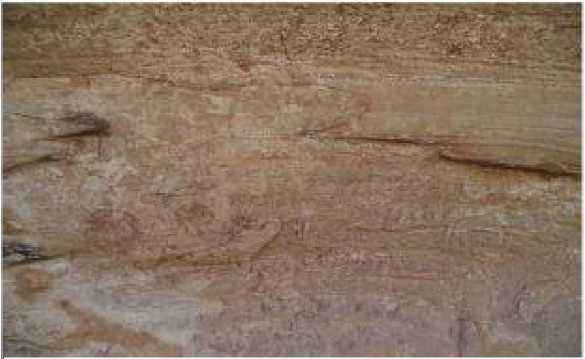
(a) Before processing with the program DStretch
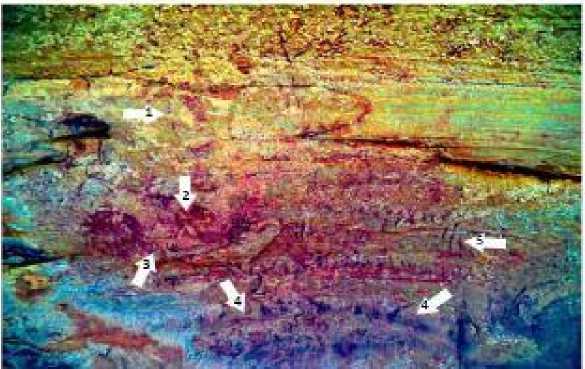
-
b. After processing with the program DStretch
Site: Ijabbaren N
Plate 0 4- 5(?) fish for the site of Sefa r
Before Processing with DStretch:
At the upper part of a rock shelter wall, two opposing bovine figures appear on the left side. They face in opposite directions and differ in their details. Both are well preserved and were executed in dark red ocher. Nearby, there is a schematic drawing also done in dark red ochre. The form suggests the shape of a fish. The end of the body is clearly represented with a double curved line.(Fig. 5-A)
After Processing with DStretch:
The schematic figure becomes clearer. It shows the outline of a fish. The caudal fin is depicted with a double curved line. The head appears pointed, although the upper part is missing. This shape seems to overlap with the limbs of a large mammal.(Fig. 5-B)
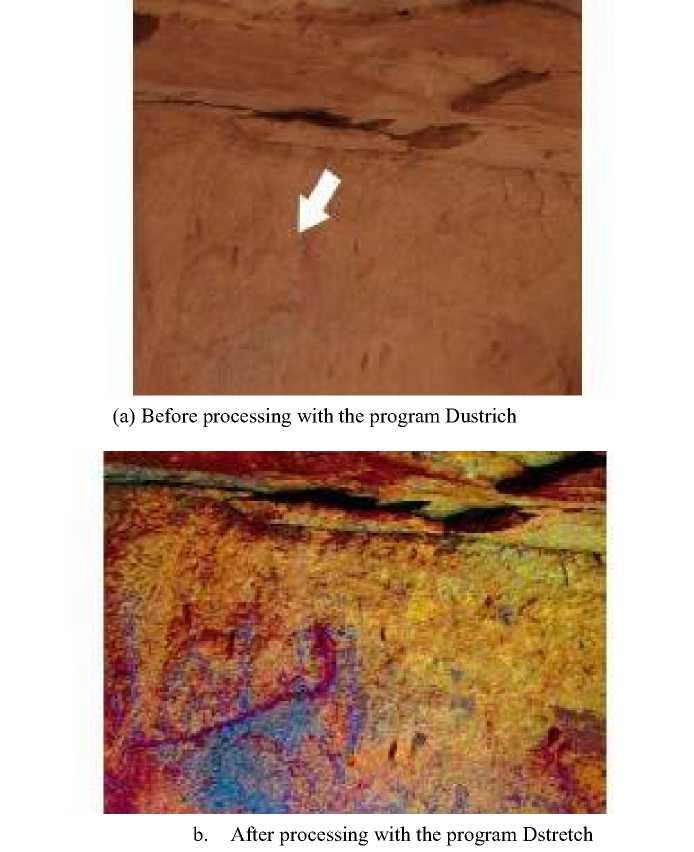
(a) Before processing with the program Dustrich b.
After processing with the program Dstretch
Plate 0 5: Fish (?) of Site 1n Ijabbaren
Site 2: Ijabbaren
Before DStretch Processing:
At the top section of a rock shelter wall, to the left of a faded depiction of a large giraffe rendered in light red ochre, we observe a schematic drawing. The giraffe itself is poorly preserved, with only the crest of the head visible, marked by several short lines. Nearby, there appears a form whose general outline suggests a fish. The upper part of the elongated body displays several short, parallel lines. On the underside, small protrusions are visible. The head is indistinct and not clearly defined.(Figure 6-A)
After DStretch Processing:
The shape becomes clearer and reveals a figure resembling a fish. Some details become visible, such as a small head and a mouth rendered in the shape of the letter “V.” A relatively thick line separates the head from the body. Along the upper side of the large, elongated body, short, thick, parallel lines extend from the end of the head to the posterior end. These may represent the dorsal fin. On the underside, two protrusions are noticeable—one near the head and another at the rear. These likely correspond to the pelvic fins. The tail or caudal fin is not clearly visible.(Figure 6-B)
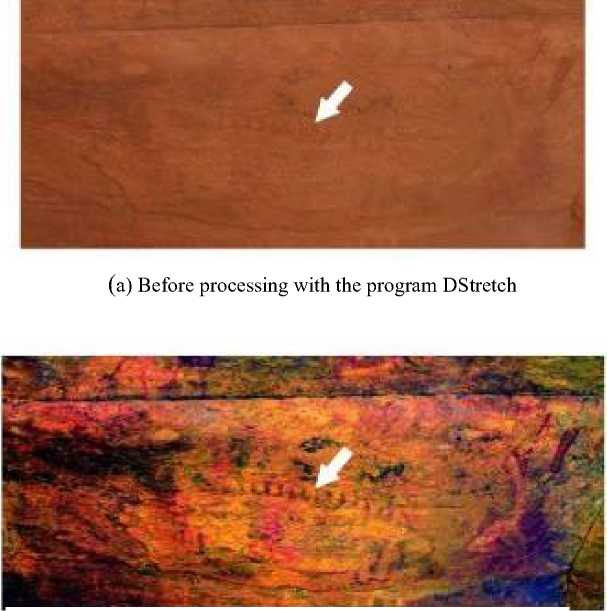
b. a fter processing with the program Dustrich
Plate 06: New fish of Ijabbaren site 2
From The side Bibliography:
In comparison with Models mentioned in the study Bibliography, Najd that this The model converge Kind of With the model that He carries number11For the board10in List that Put it both from The couple Goethe, With representation clear For the fin abdominal And the back, And representation For the mouth on appearance character(V)And also with The model that Found With yellow.
And on what It seems that this The model He mentioned it researcher Breuil, Which He said About him that it phrase on urchinepic) (Porc- , Done In ochre yellow And the same edges In ochre Al Hamra same Sizes0.105And the existing
In a position A Two giants (Figure 5.c)
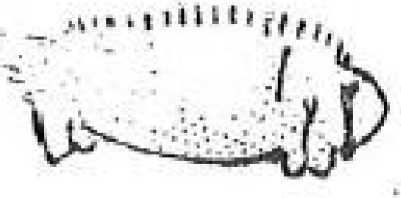
Figure 2: 5appearance fish) hedgehog According to Broy
(Breuil (AH) Lhote (H), 1952, Fig 16 a :109)
Ijabbaren Site 3:Before processing with the DStretch program:
On the right side of the shelter's rock face, we observed a sketch of a large or plump fish. The outlines were drawn with dark red ochre, and its body was filled with a white coating. Nearby, there was another figure representing a character, which is part of a group of several figures, facing the opposite direction.
The upper boundary of the fish is defined by short, somewhat parallel lines extending from a double curve located at the rear of the body, reaching the second double curve at the front of the body. These lines may serve as a separator between the area representing the tail fin, which is depicted in an oval or elliptical shape, and the head, which is not visible on the face.
Almost at the center of the fish's body, there are lines resembling the head of a small arrow, drawn with the same dark red color.
This fish is part of a group composed of two sets of figures. The first group consists of eleven figures, with the second and sixth figures holding baskets on their heads, while the third figure wears a mask adorned with horns.
The second group is positioned slightly apart from the first. It consists of four figures, one of which is only partially visible, with only the lower part of its body shown.
This second group matches another drawing, made with white ochre, which may represent a mammal. Additionally, we observed that the shape of the shelter's facade, with its curves and concavities, appears as though the group is either walking or climbing an elevation. (Plate 7-A)
After Processing with the DStretch Program:
The same details of the fish are now clearer, such as the short, closely spaced, and somewhat parallel lines along the upper edge of the body. These lines extend from the double curve at the back of the body to the second double curve at the front of the body, which may represent the dorsal fin.
Additionally, a band in the form of small arrowheads appears near the center of the body. There is also a depiction of the tail fin in an elliptical or oval shape.
An additional feature that was not visible before processing with the DStretch program is a somewhat broad protrusion along the lower edge of the body, near the head, which may represent the ventral fin.
Moreover, the lines representing the head are now more visible, shaped like a funnel, and there is a depiction of the eye. A corresponding, though clear, drawing is found near the dividing line between the body and head (Plate 7-B).
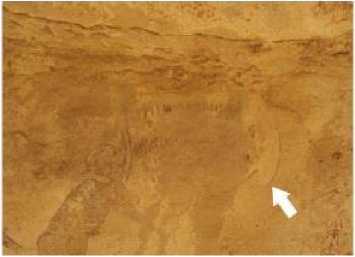
(a) Before processing with the program
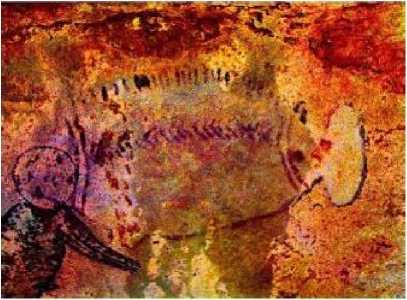
. (b)After processing with the program DStretch
Plate 7: Fish for Site 3 Ijabbaren
Bibliographic Note:
The first researcher to comment on this figure, which is associated with the round-head period, was Breuil, who described it as a fish. However, this interpretation was initially rejected by Muzzolini. Yet, he later reconsidered after finding examples of the Serpion fish, drawing comparisons between these and the fish at the Ijabbaren site, especially with the same type of dorsal fin, which was represented by small parallel lines. (Muzzolini A. 1995: 337) & (Breuil AH & Lhote H. 1952; Fig. 79)
This scene has also been noted by several other researchers, such as:
-
• Hallier UW & Hallier BC, 2013, p: 226.
-
• Gauthier Y and C , 2011, Fig. 1: 120.
Observation:
This fish appears within a scene that suggests ritualistic or symbolic practices. This raises the question of whether there is a relationship between these practices and the fish or fish in general. Were they offered as sacrifices, or did they symbolize fertility or reproduction? This is suggested by their placement within a scene depicting a series of small figures in a mating position, located to the right of the Ijbaran fish.
Ijabbaren Site 4:Before Processing with the DStretch Program:
At the top of the shelter's rock face, we observed an unusual formation. The color of the shelter's surface seems to express details of the skin or scales of reptilian animals. Above this, there are clear sketches of eroded drawings.
On the right side, a figure from the round-head period stands, arms extended (Plate 8).
After Processing with the DStretch Program:
The unusual formation is clearly visible, with the use of color on the surface to represent details that may suggest skin or scales. This indicates that preliminary work was carried out on the surface, highlighted in the image by the blue arrows.
From the right to the left of the surface, two figures appear, possibly wearing masks. These belong to the round-head period and are depicted with their arms outstretched. The advanced figure carries what seems to resemble a Naisse (a traditional object), and the shape of this figure is thick and spindle-like. This object is located beneath the left hand of the figure, where we can make out the representation of a swollen lower side. Additionally, there is the depiction of a tail in the shape of a fan, along with a faint outline of a band, possibly connecting the head to the body, represented in the image by the white arrow.
Furthermore, three large figures are depicted in a bent position, one after the other, possibly trying to touch something. This could refer to a large arc showing a distinctive shape, resembling the scales of a reptile.
In line with the first figure at the bottom, near the round-head figure, a schematic drawing of a large fish (Fish 2) is shown. This fish resembles Fish 1, appearing in a spindle-like shape, with a swollen lower side. There is also a faint representation of the tail fin.
Above this fish, there is another schematic drawing. At the head level of the first bent figure, an elliptical shape appears, which may represent the tail fin. This is accompanied by a slight bulge at the top or upper edge, as well as a vertical line that separates the body from the head.
The presence of these fish alongside the bent figures and the large arc leads us to question the relationship between them. If so, could we interpret this scene as one of fish hunting?
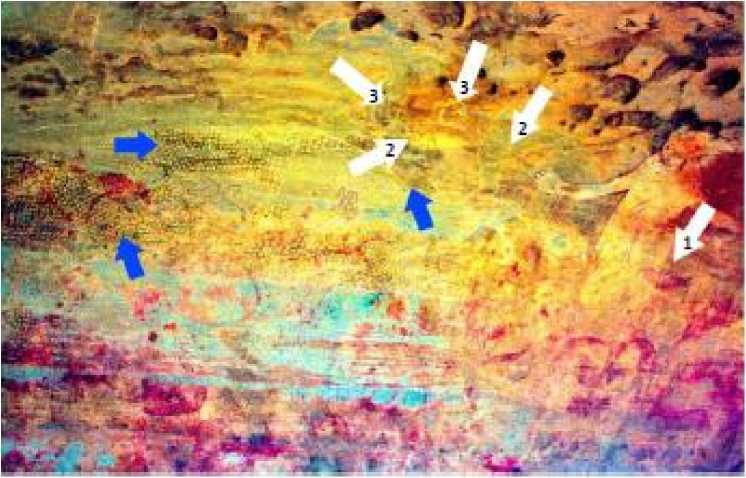
Plate 8: Three fish site 4 Ijabbaren
With the availability of water and the filling of valleys during the wet Neolithic period, fish resources became abundant. Early humans, during this prehistorical time, exploited these resources to diversify their diet. This image highlights the consumption of fish as a dietary pattern, which is further confirmed by the remains of food waste found at Neolithic sites in Tassili, such as the Tazena site. At these locations, animal remains, such as fish and turtles, were discovered. These remain indicate the presence of very humid climatic conditions, which made fish a continuous source of sustenance. (Aumassip G, Delibrias, 1982, 1983). Fish remains were also found near Djanet and in several sites in the Admer region, as well as further south in Amekni and Ain Guezzam (Soleilhavoup F., 2011; Camps G., 1968).
With the return of the wet period in the early Neolithic, desert humans experienced a more stable life. They engaged in hunting and fishing, alongside later pastoralism. Archaeological research today confirms that fish and aquatic resources were essential in ensuring daily sustenance. These resources played an important role in the diet of early humans, who were able to access those using specialized tools they had developed specifically for this activity.
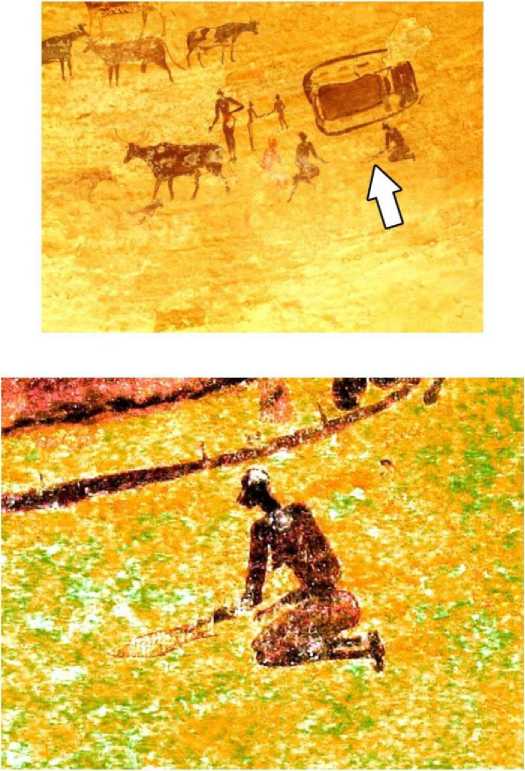
Figure 3: the negroid woman from Safar processing a fish before cooking it (Scene processed with Dstretch)

